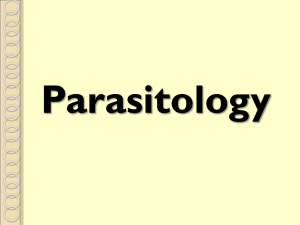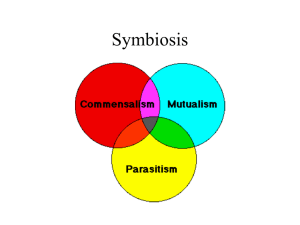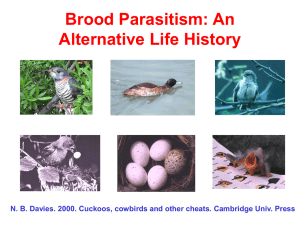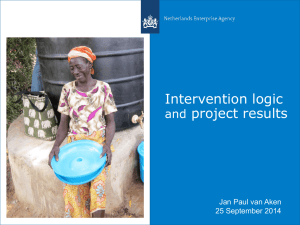Bothriocephalus barbatus
advertisement
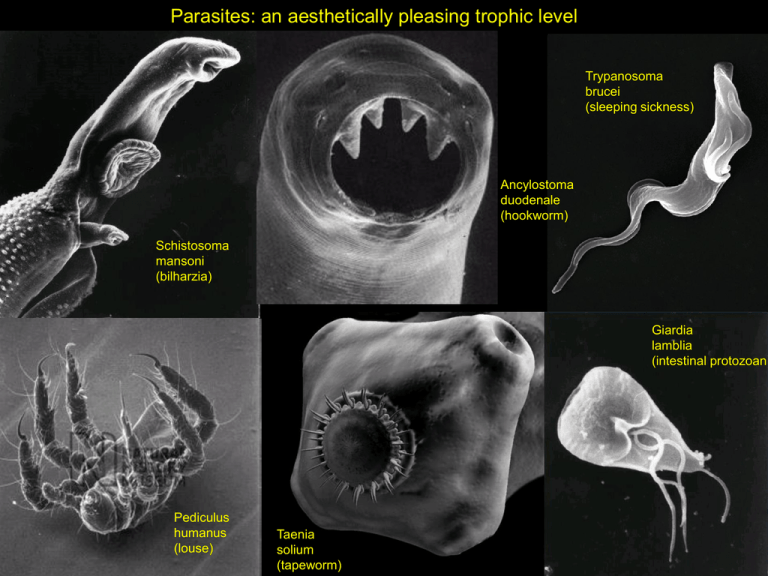
Parasites: an aesthetically pleasing trophic level Trypanosoma brucei (sleeping sickness) Ancylostoma duodenale (hookworm) Schistosoma mansoni (bilharzia) Giardia lamblia (intestinal protozoan) Pediculus humanus (louse) Taenia solium (tapeworm) What is fascinating on parasite ecology? Seemingly insanely complicated developmental cycles, including often obligatory sequence of several host species simple cycle: single host species infects itself more complicated cycle: parasite has one intermediate host even more complicated cycle: parasite has to pass through more than one intermediate host Simple cycle: most is infected from conspecific individuals Ascaris lumbricoides: intestinal parasite, eggs in faeces contaminate food Cycle with one intermediate host Fluke Fasciola hepatica Mature flukes live in hepatic biliary ducts (humans, other mammals), eggs in faeces, active larva (miracidium) emerges in water, attacks snails, where further develops (sporocyst, redia, cercaria). Active cercaria leaves the snail, encysts on water or submerged plants, waits to be eaten by the final host. Cycle with one intermediate host Schistosoma haematobium (causes bilharziasis) Mature worms in veins of urinary bladder, eggs released in urine, active larvae (miracidium) emerge in water, attack snails, where undergo further development, leave them as active swimming larvae (cercaria) attacking humans, penetrate their skin and sexually mature in them. Cycle with one intermediate host Filaria (Loa loa): Adult parasite in subcutaneous tissue of humans, larvae (microfilaria) with peripheral blood sucked by flies with Chrysops, where they develop in thoracic muscles, migrate to salivary glands and infect humans when the flies suck their blood. Cycle with two intermediate hosts Fluke Clonorchis sinensis: Adult parasite in biliary ducts of the final host (humans), eggs in faeces, in water eaten by a snail, where they develop (miracidium, sporocyst, redia, cercaria). Active larvae (cercaria) leave the snail and penetrate skin of second intermediate host - fish, where they encyst in muscle tissue (metacercaria) and wait to be eaten by the final host, where they mature. Bithynia sp. Cycle with two intermediate hosts Nematode Gnathostoma spinigerum: In final host (canine and feline predators) are embedded in stomach wall, eggs released in faeces, in water emerge larvae which are eaten by the first intermediate host (copepod Cyclops). There they wait to be eaten by second intermediate host (fish, frog, snake), which in turn needs to be eaten by the final host. If the second intermediate host is eaten by a bird, parasite can wait in this additional host to be finally eaten by feline or canine predator, but cannot sexually mature in it. Humans are not hosts, if larva is eaten, it cannot mature but wanders in the body (larva migrans). Strepsiptera (Myrmecolacidae): another example of a complex life cycle 1st instar larvae live freely, male larvae attack ants, female larvae attack grasshoppers, crickets, mantis. Further development is endoparasitic, producing flying males (killing the host) while neotenic females stay as endoectoparasites in their host where males find them, and mate with them. . Kathiritamby 2009, Annu. Rev. Entomol. 54: 227 How are new hosts incorporated into the developmental cycle direction of evolution Initially the only host species is often eaten (together with its parasite) by a predator, which becomes initially facultative, later obligatory host. The original host becomes intermediate host as the reproduction of the parasite becomes limited to the newly acquired host. immature parasites in intermediate hosts mature parasites in final host Benefits from a new host: longer reproduction or growth growth and reproduction in a single host reproduction continues in the new host growth continues in the new host How are new hosts incorporated into the developmental cycle direction of evolution Parasite's eggs released by originally only one host species are often eaten by another species, which then becomes initially only facultative, later obligatory intermediate host of the parasite. immature parasites in intermediate hosts mature parasites in final host Evolution of host cycle in flukes Alloglossidium replacement of snail by leech simplified cycle snail - crustacean initial cycle fish - snail - crustacean fish host lost crustacean exchanged for leech Transfer of viral species on humans circulation only among humans transfer from animals to humans as well as among humans transfer from animals to humans, and limited transfer among humans transfer from animals to humans only vzteklina Wolfe et al. 2007. Nature 447: 279 Plasmodium vivax: origin in SE Asia, sister species P. simium, transition from macaques 40-100,000 years ago P. vivax Plasmodium falciparum: origin in Africa, sister species P.reichenowi, transition from chimpanzees less than 50,000 years ago P. falciparum What is the new intermediate host good for? The case of related tapeworms Bothriocephalus barbatus and B. gregarius B. barbatus parasitizes flatfish, with a copepod as intermediate host. B. gregarius can also include in its cycle goby fish as an optional (paratenic) host where it can multiply and thus better infect the final host. This is indeed the case as in the Mediterranean Sea, B. barbatus parazitises only 36% of flatfish, while B. gregarius 79% of flatfish. Parasite population dynamics: Cystidicoloides tenuissima (Nematoda) 98.7% eggs originates from nematodes living in trout, 1.3% from nematodes in salmon 85.8 % eggs dies 13.5% is eaten by unsuitable insect species, 0.7% is eaten by intermediate host, mayfly larva L. marginata 81.7% infected mayfly larvae is not eaten by the final host, 17.2% is eaten by trout, 1.1% by salmon Egg survival: 18.3% from 0.7%, i.e. 1.3 eggs from 1000 develops to an adult Ability of parasite infect new hosts (infectivity ) and negative effect of parasite on its host (virulence) are correlated X - optimum balance between infectivity and virulence T m X infectivity increases with virulence a Parasite tries to maximize its life time reproduction R R = T/(m+a) T - rate of infection of new hosts m - natural mortality of non-infected host a - mortality caused by parasite (virulence) Ability of parasite infect new hosts (infectivity ) and negative effect of parasite on its host (virulence) are correlated high natural mortality of host [m1>m2] leads to higher optimum virulence of parasite [a1>a2] m1 m2 natural host mortality a2 a1 host mortality caused by parasite faster increase of infectivity (T) with virulence (a) leads to lower optimum virulence T a Progeny size per wasp (relative to uninfected wasp) Virulence decreases with the intensity of transfer of parasite from hosts to their progeny (vertical transfer) relative to transfer among unrelated individuals (horizontal transfer) Proportion of figs pollinated by only 1 wasp Figs are pollinated by fig wasps. They enter into a fig, pollinate flowers lay eggs, and die. Eggs hatch into larvae, they develop in adults - wingless males and winged females; they mate, males die, females collect pollen and leave to search for another fig. Parasitic nematodes are transferred from the female to the next generation of fig wasps developing within the fig. Evolution of virulence Virulence of species transmitted by a vector (malaria, Anopheles mosquitoes) tends to be higher than in species transmitted by direct contact among hosts (myxomatosis, rabbits). Myxomatosis, introduced to Australia to control rabbits, evolved steadily towards lower virulence. How parasites manipulate their hosts Ant (Camponotus) infected by fungus (Cordyceps unilateralis) dies with its mandibles locked onto a plant, ensuring good conditions for the spread of fungal spores by wind Cockroach (Periplaneta americana) is stung into head ganglion and paralysed by wasp (Ampulex compressa) so that it serves as a life storage of food for its larvae Cricket (Nemobius sylvestris) throws itself into water so that parasitic hairworm (Tellinii spinochordodes) can emerge from it. How parasites manipulate their hosts Larvae (metacercaria) of fluke Microphallus papillorobustus encyst in head ganglion and abdomen of their intermediate host, copepod Gammarus insensibilis. Metacercaria in the head cause positive phototaxis in their host so that it swims towards the water surface where it is more likely to be eaten by water birds - the final host of the parasite. Metacercaria in the head are intensely attacked by the host and 17% of them are encapsulated and killed, while among the metacercaria in the abdomen only 1% are killed. Gammarus insensibilis Healthy brain of copepod Gammarus insensibilis (left) and encysted fluke Microphallus papillorobustus (right) Fluke Microphallus Toxoplasmosis: humans are not the target hosts Toxoplasma gondii (Apicomplexa) final hosts are cats, eggs (oocysts) are released in faeces, further develop in intermediate hosts (birds, rodents, pigs etc.) and encyst in their muscles, waiting to be eaten with their intermediate host by their final host, feline predators. Humans can get infected by oocysts from cat faeces, of cysts in meat. How parasites manipulate their hosts Toxoplasma manipulates behaviour of its intermediate hosts (mouse) so that they become more likely to be caught by a cats, its final host. Infected mouse become attracted to (instead of repelled by) the smell of cat urine and have longer reaction time to threats. Flegr: people infected by Toxoplasma are more likely to be involved in traffic accidents - perhaps longer response time? Flegr et al.: Increased risk of traffic accidents in subjects with latent toxoplasmosis Malaria Does the parasite manipulate its mosquito hosts? Anopheles gambiae Malaria: an important factor in human evolution - 0–53% population in NG lowlands - 10% of lowland populations, protects against malaria. - up to 90% in lowlands, only 5% in mountains. Protects against severe malaria, but increases chances of mild infection, particularly in children. - relatively harmful, up to 10% in some lowlands - mild protection against malaria, total protection against cerebral malaria, homozygotes not viable Manipulation of intermediate host increases the probability of transition to the final host, but also the probability that the parasite will be killed by the intermediate host, which defends itself against manipulation probability of parasite transmission to the final host probability of parasite death caused by the intermediate host p = probability of transmission to the final host without manipulation m = probability of transmission at optimum intensity of manipulation ME = optimum investment by the parasite into host manipulation Inter-specific interactions between parasites and host manipulation When intermediate host is infected by two parasites at the same time, they can be: - species with the same final host, one of which manipulates the intermediate host, the other is passive but still benefits from the manipulation - species with the same final host, both (or none) of them manipulate the intermediate host nichž oba mezihostitele - species with different final hosts, one of them manipulates the intermediate host, the other is passive and suffers from the manipulation - species with different final hosts, both manipulate the intermediate host and thus compete one with the other for the final outcome - species with the same or different final hosts, none of them manipulates the intermediate host Why should parasites castrate their host? Castrated host no longer invests in reproduction, which means higher investment to its body, which is the parasite's resource Fluke Microphallus pseudopygmaeus chemically castrates its intermediate host, snail Onoba aculeus accelerating thus its growth rate snails castrated by the parasite (blue) grow faster than healthy snails of the same size (green) developmental cycle Autor: A. Gorbushin Interspecific competition in parasites sharing the same host distribution of tapeworm Hymenolepis and Moniliformis in the intestine of rats Each species exhibits its optimum in single infections, changes during simultaneous infections are due to inter-specific competition Hymenolepis prefers anterior part of gut but is displaced by Moniliformis during simultaneous infections Niche segregation in communities of parasites distribution of parasitic nematods in the intestine Beta diversity in communities of parasitic helminths


